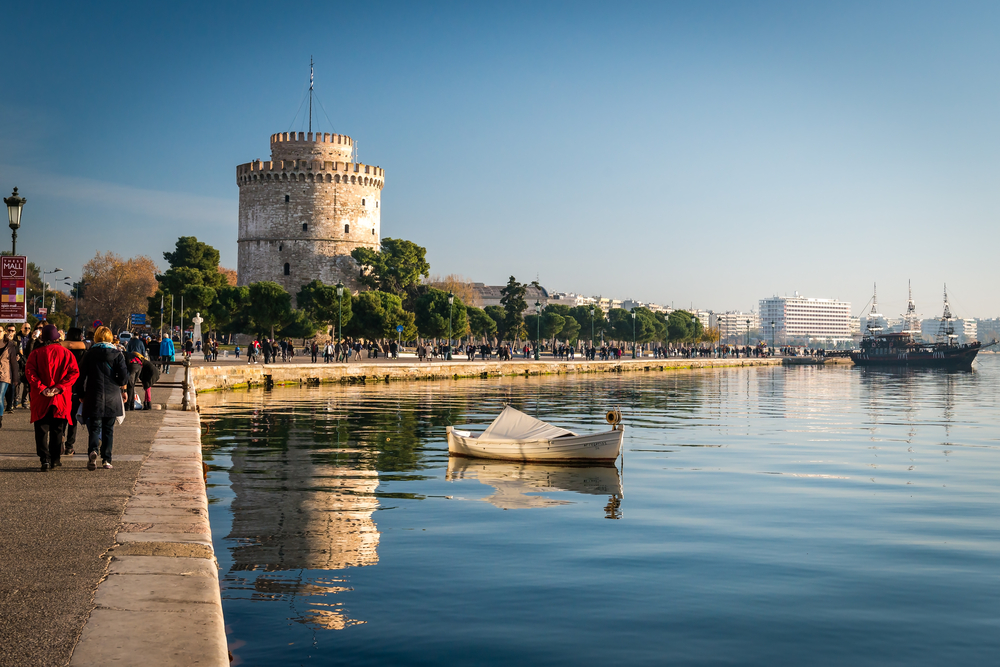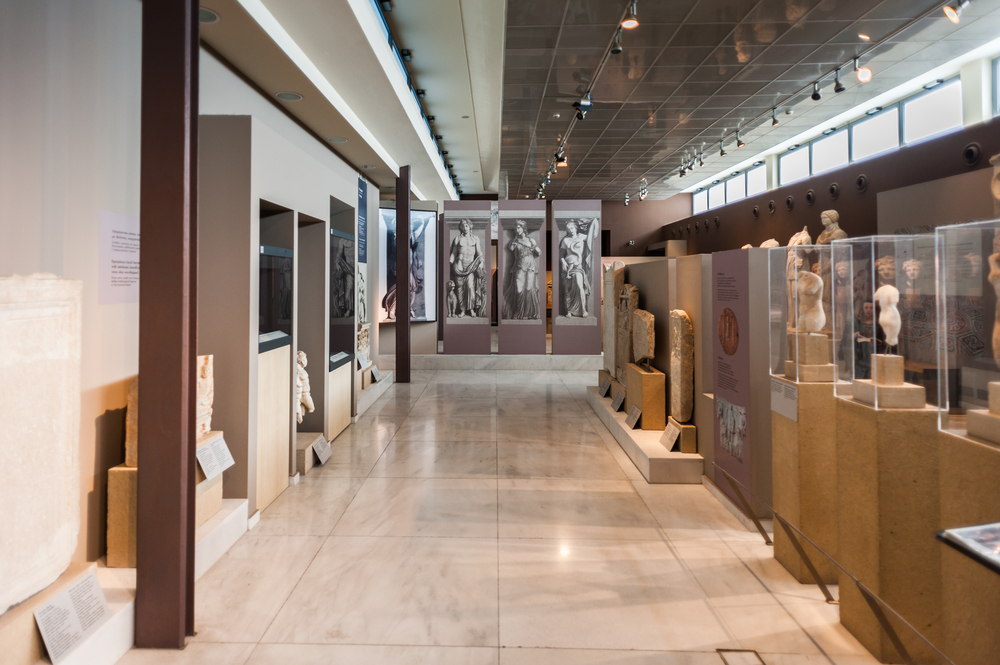Thessaloníki’s biggest museums, its university and fair are clustered just south of the city centre. Beginning at the esplanade in front of the White Tower, the 3.5km waterfront promenade was completed in 2013 around the city’s new landmark: the cascading Umbrellas (1997) by sculptor George Zongolópoulos (1903–2004), reflecting the colours of the sky and sea and beautifully illuminated at night.
White Tower
Thessaloníki’s landmark tower with its massive 360° views began as part of the seafront walls of Theodosius, but at the end of the 15th century it was rebuilt as a stout 32m cylinder, probably by the Venetians. Under the janissaries, the Sultan’s praetorian guard who were a law unto themselves, it earned the name Bloody Tower for the frequent executions within its walls. When Sultan Mahmoud II purged the janissaries in 1825, the tower was whitewashed (the story goes that a prisoner offered to do the work himself in exchange for freedom) and has been the White Tower ever since.

It has served numerous purposes over the decades: as part of the city’s air defences and a communications tower for the Allies in World War I, as a meteorological station for the University and, today, as an exhibition space, over six floors, on Thessaloníki’s history. A statue of Philip II scrutinises the tower with his one bad eye from across Leofóros Mégas Aléxandros, while towards the waterfront a large equestrian statue of Alexander the Great (1973), the son who inherited his ambitions, has become a favourite photo spot.
Archaeology Museum
Thessaloníki’s archaeology museum is one of the best in Greece, highlighting the extraordinary wealth and craftsmanship of Ancient Macedonia. Before you go inside, though, have a look at the replicas of 2nd-century bc Las Incantadas (see box, page 75) recently gifted from the Louvre, decorated with figures of a Maenad, Dionysus, Ariadne, Leda, Ganymede, one of the Dioscuri, Victory and Aura, a personification of the breeze. Inside, the exhibits are arranged thematically. The lower level is dedicated to Prehistoric Macedonia, with finds from a 23m mound (or tell) from c3200bc in Toúmba, the neighbourhood just south of the centre – mounds that later inhabitants considered magical places.

On the ground floor, the section Towards the Birth of Cities (1100–700bc) has finds from the colonies from southern Greece set up in the north, which influenced the then-coalescing kingdom of Macedonia. Next, Macedonia from the 7th century bc to Late Antiquity has intriguing everyday items, including some fine vases and sculptures – the torso of a kouros in a clingy robe, a Classical-era funeral stele from Néa Kallikráteia of a girl holding a dove, and later sculptures, imbued with a homely charm as proportions start to waver from the golden mean. The section on Thessaloníki has a superb 4th-century bc marble door of a Macedonian tomb with all its bronze fittings: wheels once allowed it to open effortlessly.
Another tomb, robbed just before it was excavated in 1984, still yielded beautiful marble couches charmingly painted with griffons, a bull, gods and a red-shoed Silenus. There’s the lovely 5th-century bc Aphrodite of Thessaloníki, displays on Galerius’ ambitious building programme and finds from his palace, including a painterly mosaic of Ariadne and Dionysos from the 3rd century ad. The Roman statues include an Augustus as a hero, an early example of the ‘propaganda’ statues erected across the empire (later, the Romans would save money by sending out bodies in togas with replaceable heads).
There’s also part of the Ionic temple of Aphrodite discovered in 2000 in Plateía Antigonidón. It has an unusual history: it was built in Ancient Ainea (near the modern beach resort of Epanomí), a once prosperous city reputedly founded by and named aft er Aeneas, Aphrodite’s son, then hurriedly disassembled and relocated to Thessaloníki aft er the Battle of Actium, because the city supported loser Antony and needed to butter up victor Octavian (soon to be Augustus), whose great uncle Julius Caesar claimed descent from Aphrodite. Th e last section is dedicated to the Gold of Macedonia, the metal that funded Philip II’s meteoric rise to power.
There are dazzling displays of gold from 121 6th century BC tombs in Síndos, in the suburbs of Th essaloníki. Men were buried with their weapons, women with their jewellery, and both with miniature items useful in the aft erlife – furniture and mule carts, one pulled by terracotta mules. Some tombs contained gold masks or lozenges that covered the mouths of the dead. You need a magnifying glass to pick out the granulation and filigree on the necklaces. A cemetery in Dervéni, on the road to Kavála, yielded a glittering hoard from the second half of the 4th century bc, including one of the great masterpieces of Hellenistic art: the bronze Dervéni Krater (c320BC), the only intact relief metal vase to survive antiquity, made with such a high quantity of tin in the alloy that it looks gold-plated. According to its inscription, its owner was a nobleman of Lárissa, probably a hostage of Philip II; its creator was a Greek Cellini, who some critics have tentatively identifi ed as Lysippus. Th e theme is a Dionysian revel. Hammered out in the most exquisite repoussé, ecstatic bacchants whirl in fluttering garments across the main body of the vase, watched by a man wearing one boot, identified as Thracian king Lykourgos, who was punished by Dionysos with madness for his impiety.
Ariadne and Dionysos are shown seated, Ariadne pulling back her veil as her husband stretches a sensuous leg over her thigh. The other elements are of cast bronze – the extraordinary four figures weary from the dance around the neck: Dionysos and a maenad, and a satyr and maenad who are the very definition of erotic languor. Even the handles are unique, anticipating rococo soup tureens, decorated with bearded heads framed in screw-tailed snakes. The next exhibit, the Derveni Papyrus (340bc) has been recognised by UNESCO as ‘Europe’s oldest book’. It was bizarrely preserved by being burnt in a funeral pyre (usually papyrus can’t survive in the damp Greek soil). The 266 fragments, laboriously recovered and translated into modern Greek and English, hold a copy of late 5th-century bc hexameter poem ascribed to Orpheus that starts ‘Close the doors, you uninitiated’. Written in an allegory full of secret meanings, it appears (to the uninitiated) full of fuzzy philosophical ramblings about the essence of Zeus.
Museum of Byzantine Culture
Where the archaeological collection ends, this museum, directly behind, picks up the story. Early Christian art shows the continuity of pagan styles, even in the tombs, although instead of ‘Farewell’ the epitaphs read ‘Sleeping’ or ‘At Rest’. The earliest art here emphasises hope – the young, beardless Good Shepherd amid sweet visions of a heaven filled with birds, fruit and wine: crucifixions wouldn’t become popular until the 6th century ad. And judging by the mosaic floor and paintings from a 5th-century ad dining room, life on earth, at least for some, was good, too.
There are bittersweet photos of the mosaics in the Basilica of Ag Dimítrios, lost in the fire of 1917, and a fresco showing Susannah and the Elders, unique in Greece. After the puritanical Iconoclasm, there was an explosion of art to fill the new monasteries founded by the Macedonian emperors (ad 867–1056). There’s also a video installation on the Byzantine castles along the Via Egnatía, gorgeous icons, and a chic café/restaurant.
Macedonian Museum of Contemporary Art (MMCA)
International art dealer Alexander Iólas was instrumental in founding this museum after the earthquake of 1978, donating 47 works by artists such as Andy Warhol (who was first discovered by Iólas in New York in the late 1940s) and Niki de Sainte-Phalle. Today it boasts more than 1,800 pieces, and is the main sponsor of the Thessaloníki Biennale of Contemporary Art (in odd-numbered years).
War Museum of Thessaloníki
The all-too-frequent conflicts that took place in Greece in the 19th and 20th centuries are the subject here, with collections of uniforms, posters, weapons, medals, awards and photographs. There’s also a large exhibit on singer Sofía Vémbo, whose songs boosted Greek morale during World War II.
Aristotle University of Thessaloníki (AUTH)
Founded in 1925, in the newly liberated territories of northern Greece, the university’s main building is in a mansion that had been converted into a military hospital on Éthnikis Amýnis Street. The university has several museums, many awaiting renovation – including the fascinating Criminology Museum.